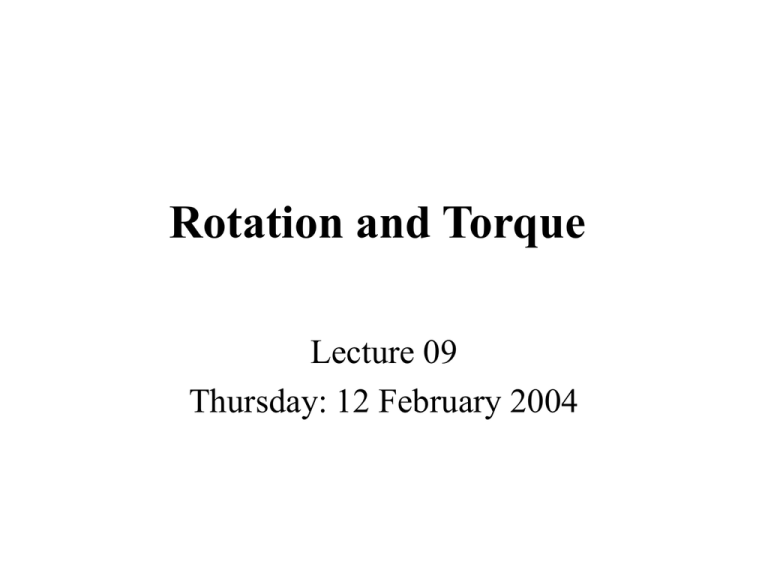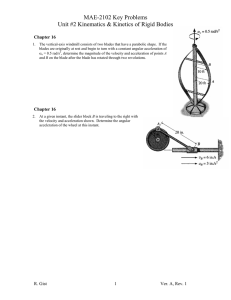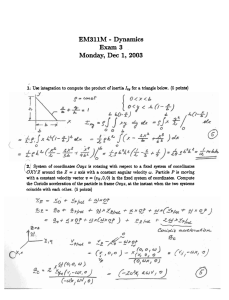Rotation and Torque Lecture 09 Thursday: 12 February 2004
advertisement

Rotation and Torque Lecture 09 Thursday: 12 February 2004 ROTATION: DEFINITIONS • Angular position: • Angular displacement: q q 2 – q 1 = Dq q 2 q1 Dq Ave.Angular velocity: ave t2 t1 Dt Instantaneous Angular velocity: dq dt What is the direction of the angular velocity? •Use your right hand •Curl your fingers in the direction of the rotation •Out-stretched thumb points in the direction of the angular velocity DEFINITIONS (CONTINUED) Averageangular acceleration : 2 1 D avg t2 t1 Dt d Instantaneous angular acceleration : dt Direction of Angular Acceleration The easiest way to get the direction of the angular acceleration is to determine the direction of the angular velocity and then… • If the object is speeding up, velocity and acceleration must be in the same direction. • If the object is slowing down, velocity and acceleration must be in opposite directions. For constant 0 t x q v a q q 0 0t t 1 2 2 02 2 (q q 0 ) q q 0 12 ( 0 )t q q 0 t 12 t 2 2 Relating Linear and Angular Variables s qr v r at r v r 2 ac r r r 2 2 2 Three Accelerations 1. Centripetal Acceleration 2 v (radial component of the linear acceleration) a c -always non-zero in circular motion. r 2. Tangential Acceleration (component of linear acc. along the direction of the velocity) -non-zero if the object is speeding up or slowing down. 3. Angular Acceleration (rate of change in angular velocity) aT r -non-zero is the object is speeding up or slowing down. Energy Considerations Although its linear velocity v is zero, the rapidly rotating blade of a table saw certainly has kinetic energy due to that rotation. How can we express the energy? We need to treat the table saw (and any other rotating rigid body) as a collection of particles with different linear speeds. KINETIC ENERGY OF ROTATION Ki m v 2 i i 1 2 K Ki 1 2 m v 2 i i vi ri K 1 2 m i r 2 2 i 1 2 K I 1 2 Where m r 2 i i 2 I mi ri 2 2 Defining Rotational Inertia •The larger the mass, the smaller the acceleration produced by a given force. F ma •The rotational inertia I plays the equivalent role in rotational motion as mass m in translational motion. •I is a measure of how hard it is to get an object rotating. The larger I, the smaller the angular acceleration produced by a given force. Determining the Rotational Inertia of an Object I is a function of both the mass and shape of the object. It also depends on the axis of rotation. 1. For common shapes, rotational inertias are listed in tables. A simple version of which is in chapter 11 of your text book. 2. For collections of point masses, we can use : i N I mi ri 2 i 1 where r is the distance from the axis (or point) of rotation. 3. For more complicated objects made up of objects from #1 or #2 above, we can use the fact that rotational inertia is a scalar and so just adds as mass would. Comparison to Translation • x q • v • a • mI • K=1/2mv21/2I2 Force and Torque I Torque as a Cross Product r F r F sin q (Like F=Ma) The direction of the Torque is always in the direction of the angular acceleration. • For objects in equilibrium, =0 AND F=0 Torque Corresponds to Force • Just as Force produces translational acceleration (causes linear motion in an object starting at rest, for example) • Torque produces rotational acceleration (cause a rotational motion in an object starting from rest, for example) • The “cross” or “vector” product is another way to multiply vectors. Cross product results in a vector (e.g. Torque). Dot product (goes with cos q) results in a scalar (e.g. Work) An Example r F Sin q xmg x W Forces on “extended” bodies can be viewed as acting on a point mass (with the same total mass) At the object’s center of mass (balancing point) Determining Direction of A CROSS PRODUCT r F Angular Momentum of a Particle • Angular momentum of a particle about a point of rotation: l rp l r P Sinq • This is similar to Torques rF r F Sinq Find the direction of the angular momentum vector-Right hand rule P r r P Does an object have to be moving in a circle to have angular momentum? • No. • Once we define a point (or axis) of rotation (that is, a center), any object with a linear momentum p that does not move directly through that point has an angular momentum defined relative to the chosen center as Lrp





